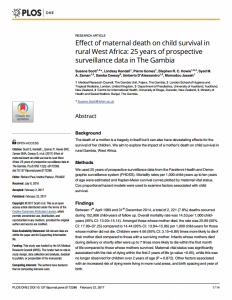
Background
The death of a mother is a tragedy in itself but it can also have devastating effects for the survival of her children. We aim to explore the impact of a mother’s death on child survival in rural Gambia, West Africa.
Methods
We used 25 years of prospective surveillance data from the Farafenni Health and Demographic surveillance system (FHDSS). Mortality rates per 1,000 child-years up to ten years of age were estimated and Kaplan-Meier survival curves plotted by maternal vital status. Cox proportional hazard models were used to examine factors associated with child survival.
Findings
Between 1st April 1989 and 31st December 2014, a total of 2, 221 (7.8%) deaths occurred during 152,906 child-years of follow up. Overall mortality rate was 14.53 per 1,000 child-years (95% CI: 13.93–15.14). Amongst those whose mother died, the rate was 25.89 (95% CI: 17.99–37.25) compared to 14.44 (95% CI: 13.84–15.06) per 1,000 child-years for those whose mother did not die. Children were 4.66 (95% CI: 3.15–6.89) times more likely to die if their mother died compared to those with a surviving mother. Infants whose mothers died during delivery or shortly after were up to 7 times more likely to die within the first month of life compared to those whose mothers survived. Maternal vital status was significantly associated with the risk of dying within the first 2 years of life (p-value <0.05), while this was no longer observed for children over 2 years of age (P = 0.872). Other factors associated with an increased risk of dying were living in more rural areas, and birth spacing and year of birth.
Conclusions
Mother’s survival is strongly associated with child survival. Our findings highlight the importance of the continuum of care for both the mother and child not only throughout pregnancy, and childbirth but beyond 6 weeks post-partum.